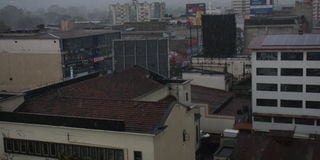Mazingira Day: Once famed as the cleanest town, Nakuru now battles pollution and flooding

A photo of the city center during heavy rainfall. The photo was taken on September 2, 2025.
In the late 90s and early 2000s, Nakuru was the pride of East Africa, setting an example for cleanliness, order and environmental awareness. The streets were spotless, trees lined every avenue, and residents took pride in maintaining the town’s beauty.
"There was a time when Nakuru was the cleanest town in East Africa, and that was very much the case. I moved here from Nairobi in the late '90s, and back then people were very aware of environmental conservation. Everyone played their part in keeping the town clean," recalls Barbushe Maina.
Barbushe remembers a Nakuru brimming with life Lake Nakuru National Park was lush and green, and its waters were clear and inviting.
"Seventy-five per cent of the park was covered in forest. It was a marvellous place. People would regularly visit to take part in clean-up activities, and it was well maintained,” he says.
Today, that image has faded. Lake Nakuru is becoming increasingly polluted, and rising water levels are threatening nearby settlements and biodiversity.
Residents say that the town, which was once beautiful, has lost its sparkle. “The Nakuru we have now is just a shadow of what it was,” laments Barbushe.
In Kivumbini, long-time resident Dennis Kunga says that flooding has become a major problem, something that was unheard of in the town's past.
“Before 2008, rainwater was never a threat. Nowadays, whenever it rains, areas such as Bondeni, Manyani and Kivumbini experience flash floods. The roads become impassable, and the runoff carries waste downstream, creating health risks," he says.
Further out in Njoro, Sospeter Njuguna remembers when the Ndarugu River was clean enough to swim in.
“Back in the ’90s, we used to play in the river and collect water for cleaning. Today, due to urbanisation and pollution, the water in the river has turned toxic,” he says.
A previous investigation by Mtaa Wangu in August highlighted how rapid urbanisation in Nakuru's upper estates, including Milimani and parts of the city centre, has worsened flooding for residents living downstream in Manyani, Pondamali and Rhonda.
At the time, the County Executive for Roads, Eng. Michael Kamau, attributed the flooding to unregulated construction and the loss of natural drainage.
“Most of the water that would previously have been absorbed into the ground now flows downstream due to paved compounds and increased development,” he explained.
Environmental experts say the city’s problems stem from poor planning and the absence of a sustainable drainage strategy.
"The challenge Nakuru faces is that we don’t have a drainage master plan. We need a city-wide stormwater plan to manage runoff, especially in downstream areas," says Jackson Raini, an environmentalist.
Raini is calling for the adoption of the “sponge city” concept — a model that allows rainwater to be absorbed into the ground through green spaces and permeable surfaces, rather than channelling it into low-income neighbourhoods.
"There’s also an urgent need for urban greening and the conservation of Menengai Forest," he adds.
However, county officials say efforts are underway to reverse the damage. During the First Lady’s Mazingira Awards (FLAMA), which took place at State House on October 8, Governor Susan Kihika outlined the steps that her administration is taking to restore Nakuru’s environmental integrity.
"The county has committed to planting one million trees each year. Through the Financing Locally-Led Climate Action (FLLoCA) programme, we have also launched projects to restore six riparian zones, while promoting school-based initiatives that combine education with practical action," she said.
As Nakuru grapples with the effects of rapid urbanisation, its residents, from environmentalists to ordinary citizens, say their dream is to reclaim the city’s lost glory.

